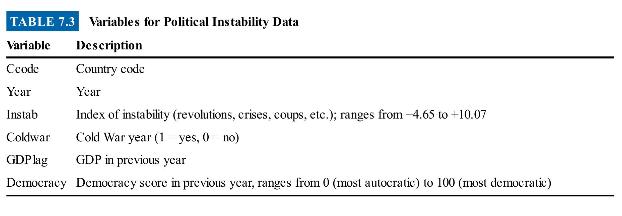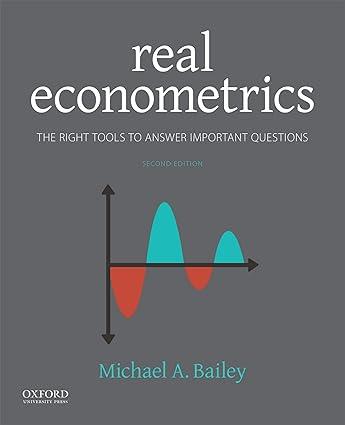The relationship between political instability and democracy is important and likely to be quite complicated. Do democracies
Question:
The relationship between political instability and democracy is important and likely to be quite complicated. Do democracies manage conflict in a way that reduces instability, or do they stir up conflict? Use the data set called Instability_PS data.dta from Zaryab Iqbal and Christopher Zorn (2008) to answer the following questions. The data set covers 157 countries between 1946 and 1997. The unit of observation is the country-year. The variables are listed in Table 7.3.
(a) Estimate a bivariate model with instability as the dependent variable and democracy as the independent variable. Because the units of the variables are not intuitive, use standardized coefficients from Section 5.5 to interpret. Briefly discuss the estimated relationship and whether you expect endogeneity.
(b) To combat endogeneity, include a variable for lagged GDP. Discuss changes in results, if any.
(c) Perhaps GDP is better conceived of in log terms. Estimate a model with logged-lagged GDP, and interpret the coefficient on this GDP variable.
(d) Suppose we are interested in whether instability was higher or lower during the Cold War. Run two models. In the first, add a Cold War dummy variable to the preceding specification. In the second model, add a logged Cold War dummy variable to the above specification. Discuss what happens.
(e) It is possible that a positive relationship exists between democracy and political instability because in more democratic countries, people feel freer to engage in confrontational political activities such as demonstrations. It may be, however, that this relationship is positive only up to a point or that more democracy increases political instability more at lower levels of political freedom. Estimate a quadratic model, building off the specification above. Use a figure to depict the estimated relationship, and use calculus to indicate the point at which the sign on democracy changes.

Data From Section 5.5:
We frequently want to compare coefficients. That is, we want to say whether X1 or X2 has a bigger effect on Y. If the variables are on the same scale, this task is pretty easy. For example, in the height and wages model, both adolescent and adult height are measured in inches, so we can naturally compare the estimated effects of an inch of adult height versus an inch of adolescent height.
Step by Step Answer:

Real Econometrics The Right Tools To Answer Important Questions
ISBN: 9780190857462
2nd Edition
Authors: Michael Bailey





